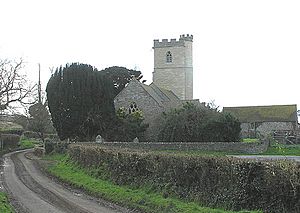All Saints Church, Otterhampton facts for kids
Quick facts for kids All Saints Church |
|
|---|---|
 |
|
| Location | Otterhampton, Somerset, England |
| Built | 14th century |
|
Listed Building – Grade II*
|
|
| Official name: Church of All Saints | |
| Designated | 29 March 1963 |
| Reference no. | 1344927 |
| Lua error in Module:Location_map at line 420: attempt to index field 'wikibase' (a nil value). | |
All Saints Church is a very old and special building in Otterhampton, Somerset, England. It sits near the River Parrett. This church was built a long, long time ago, in the 1300s. It's so important that it's officially recognized as a Grade II* listed building. This means it's a historic place that needs to be protected. Today, it's looked after by the Churches Conservation Trust. This trust helps to save old churches that are no longer used for regular services. All Saints Church became part of their care in 1989.
Contents
History of All Saints Church
Early Beginnings
A church has stood on this spot since the 1100s. The building you see today mostly comes from the 1300s. It was first named after Saint Peter. Later, its name was changed to All Saints.
The Tower and Bells
The tall tower on the west side of the church was added later. It was built in a style called Perpendicular Gothic. Inside the tower, there is a special frame for bells from the time of Queen Elizabeth I. There are four bells in total. One bell is from the 1500s. Two others are from 1617 and 1737.
Inside the Church
Historic Features
When you go inside All Saints Church, you can see many old things. There is a font, which is a basin used for baptisms. This font is very old, from the Norman period (around the 11th or 12th century). It has a cover from the Jacobean period (early 1600s). You can also see a screen from the 1500s. The communion rails, which are fences around the altar, are from the 1600s.
Current Use
The church stopped being used for regular services in 1988. Since 1989, it has been cared for by the Churches Conservation Trust. This organization works to protect historic churches across England. They make sure these special buildings are kept safe for everyone to visit and enjoy.
See also

